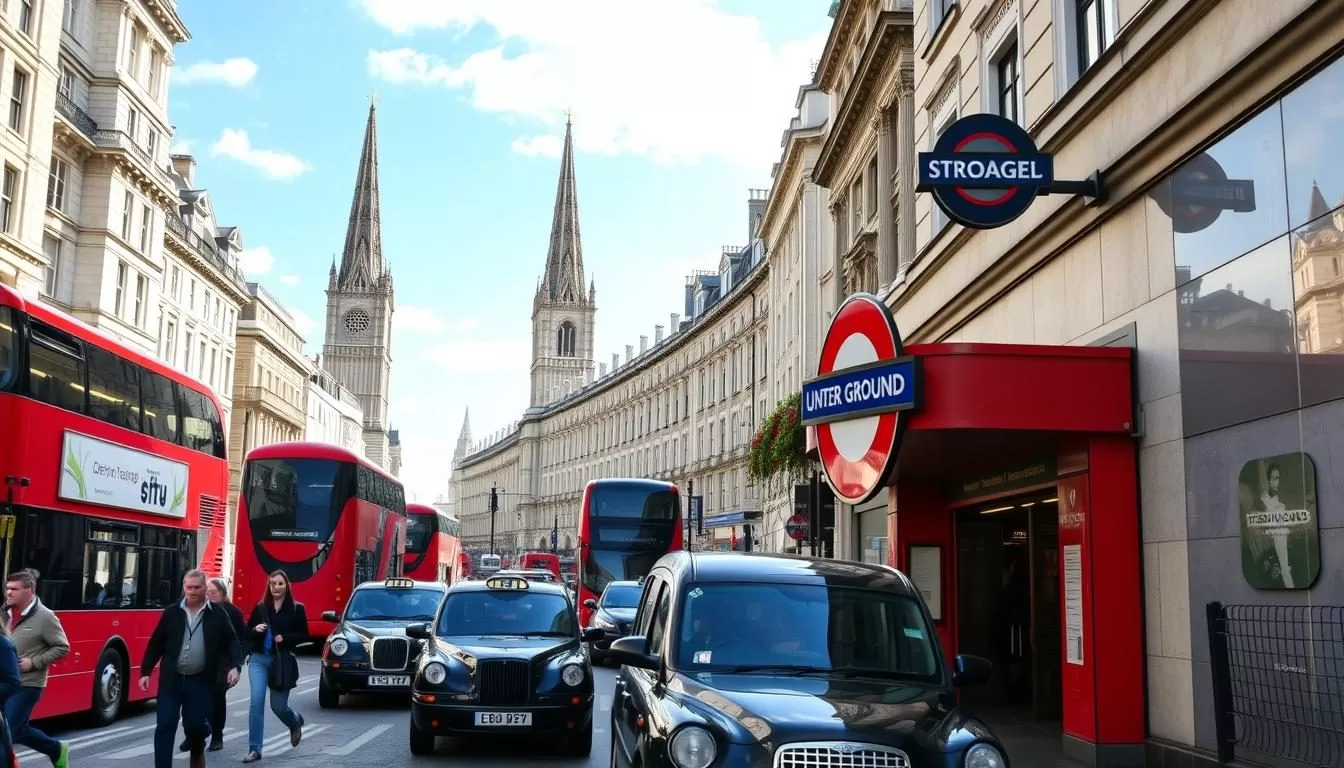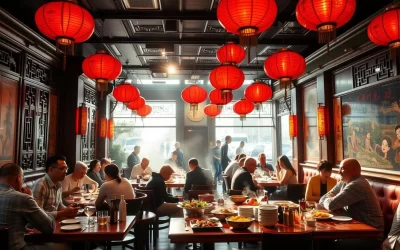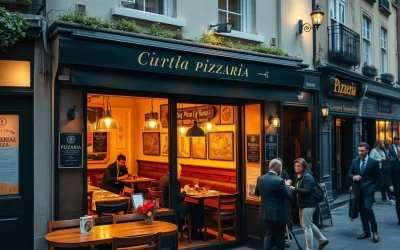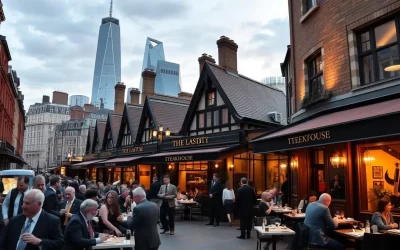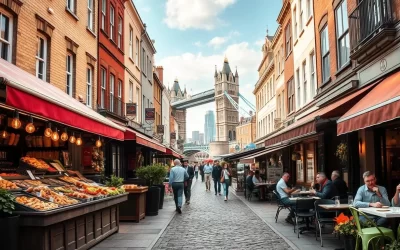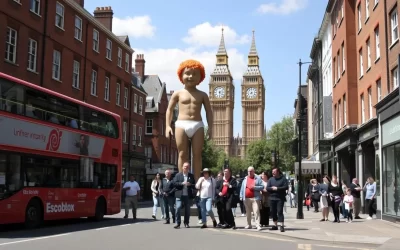Welcome to your comprehensive guide to exploring one of the world’s most historic cities – London. With a vast transport network at your disposal, getting around can be a breeze.
You’ll discover multiple options to get around London efficiently, from the iconic Underground to the famous black cabs. Understanding the various ways to navigate this city will save you time, money, and stress during your visit.
With this guide, you’ll be able to plan your route, choose the best payment options, and make the most of your time in London.
Understanding London’s Public Transport System
London’s comprehensive public transport system can be daunting, but it’s easier to navigate once you know the basics. London is served by an integrated network of transport services, making it relatively straightforward to get around once you understand how it works.
Transport for London (TfL) Overview
Transport for London (TfL) is the government body responsible for managing all aspects of London’s transport system. This includes everything from the London Underground to buses, trams, and river services. TfL ensures that all these different modes of transport work together seamlessly, making it easy for you to travel across the city.
London’s Transport Zones Explained
London is divided into nine concentric fare zones, with Zone 1 covering the city center and Zone 9 reaching the outer suburbs. Most tourist attractions are located within Zones 1 and 2. The fare you pay is directly related to the number of zones you travel through, so understanding these zones is crucial for budgeting your transport costs.
| Zone | Description | Examples of Locations |
|---|---|---|
| Zone 1 | Central London | Westminster, Covent Garden |
| Zone 2 | Inner suburbs | Camden, Kensington |
| Zone 6 | Outer suburbs | Heathrow Airport |
Payment Options for London Public Transport
When traveling in London, you’ll find multiple convenient ways to pay for your journeys. London’s public transport system is designed to be accessible, with various payment options to suit different needs.
Contactless Cards and Mobile Payments
You can use contactless payment methods, such as credit or debit cards and mobile devices (e.g., Apple Pay, Google Pay), to travel on London’s public transport. Simply tap your card or device when you start and end your journey. This method is convenient and doesn’t require purchasing a separate ticket.
Oyster Cards vs. Visitor Oyster Cards
An Oyster card is a reloadable smart card that can be used across all transport modes in London. You pay a £7 refundable deposit and add credit as needed. A Visitor Oyster card is specifically designed for tourists and can be purchased before arriving in London, coming pre-loaded with credit. Both offer pay-as-you-go options and daily/weekly capping.
Travelcards and Paper Tickets
For longer stays or specific travel needs, you can opt for Travelcards or paper tickets. Travelcards offer unlimited travel within certain zones for a set period (1-day, 7-day, or monthly). They can be loaded onto an Oyster card or purchased as paper tickets.
| Payment Method | Description | Benefits |
|---|---|---|
| Contactless Payment | Using credit/debit cards or mobile devices | Convenient, no ticket purchase needed |
| Oyster Card | Reloadable smart card | Pay-as-you-go, daily/weekly capping |
| Visitor Oyster Card | Pre-loaded smart card for tourists | Convenient, discounts at select attractions |
| Travelcards | Unlimited travel within specific zones | Ideal for longer stays or frequent travel |
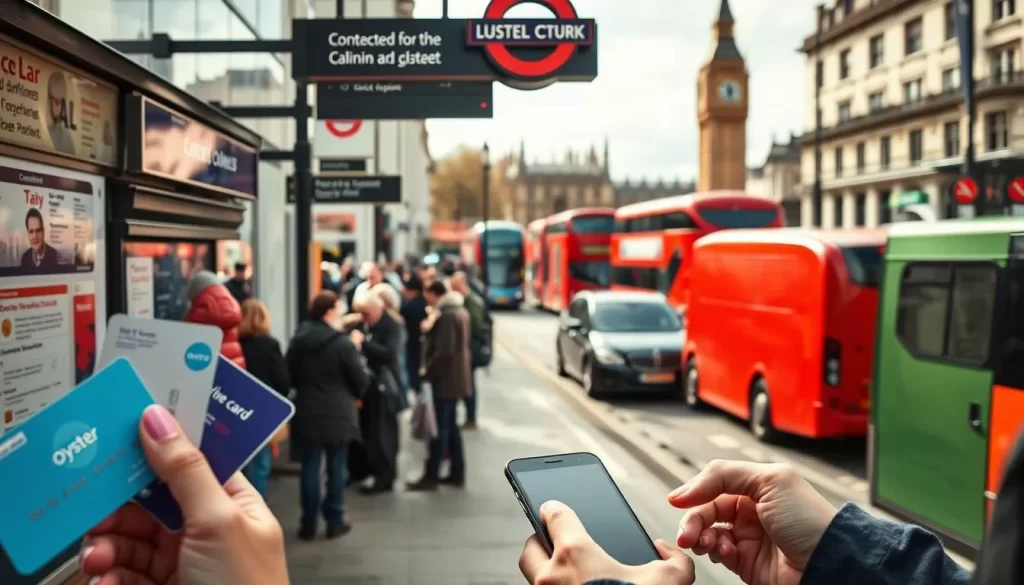
Navigating the London Underground
The Tube is not just a mode of transport; it’s an iconic symbol of London, and understanding how to use it is essential for any visitor. The London Underground, or “Tube,” is the oldest underground metro network in the world, with parts operating since 1863.
Today, it carries over a billion passengers a year across 270 stations and 250 miles of track. With such an extensive network, knowing how to navigate it is crucial for a smooth journey.
Understanding the Tube Map
The iconic Tube maps are a crucial tool for navigating London. While not geographically accurate, they clearly show the different colored lines and their connections, making it relatively easy to plan your journey between stations.
You can find these maps at every Tube station and on the Transport for London (TfL) website.
Peak Hours and When to Avoid
For a more comfortable experience, avoid traveling during weekday rush hours (7:30-9:30 am and 4:30-7:00 pm) when trains become extremely crowded with commuters.
If you can, plan your journey during off-peak hours for a more relaxed trip.
Tips for Efficient Tube Travel
When planning your Tube journey, remember that walking might sometimes be faster for short distances—stations that appear far apart on the Tube map might actually be just a few minutes’ walk from each other above ground.
Always stand on the right side of escalators to allow people to walk past on the left, and have your payment card or ticket ready before approaching the barriers to keep traffic flowing smoothly.
| Time of Day | Frequency of Trains |
|---|---|
| Peak Hours (7:30-9:30 am & 4:30-7:00 pm) | Every 2-5 minutes |
| Off-Peak Hours | Every 5-10 minutes |
| Night Tube (Fridays & Saturdays) | Every 10-15 minutes |
London’s Bus Network
With over two billion journeys annually, London’s buses are the most used form of public transport in the city. The bus network is incredibly comprehensive, covering a vast area and providing services to numerous neighborhoods and attractions that aren’t always accessible by rail.
How to Use London Buses
Using London’s buses is straightforward. You simply tap your payment card on the yellow reader when boarding—there’s no need to tap when exiting—and enjoy a flat fare of £1.75, regardless of the distance traveled. The “Hopper” fare is a convenient feature that allows you to take unlimited bus journeys within one hour of your first tap, all for the price of a single fare.
Night Buses and 24-Hour Routes
London’s bus network also includes night buses and 24-hour routes, ensuring you can get around the city at any time. Night bus routes are prefixed with “N,” and they operate when the Tube is closed, providing a vital way to travel across London. With so many bus routes available, you’re never far from your destination.
- London’s iconic red double-decker buses are a symbol of the city.
- The bus network is extensive, reaching areas not covered by rail services.
London Overground and DLR Services
London’s transport network is further enhanced by the London Overground and Docklands Light Railway (DLR) services. These rail services complement the Underground, providing coverage to areas not served by the Tube.
Where the Overground Will Take You
The London Overground, identifiable by its orange logo, forms a ring around central London, connecting outer neighborhoods and making it a valuable option for journeys that would otherwise require multiple Tube changes. With modern trains and improved accessibility features, Overground stations offer a more pleasant travel experience compared to the often crowded Underground stations.
Using the Docklands Light Railway
The DLR is a fully automated, driverless light rail system serving East and Southeast London, including popular destinations like Canary Wharf, Greenwich, and London City Airport. As part of London’s integrated transport network, the DLR accepts the same payment methods as other services, including Oyster and contactless cards at all its stations. Enjoy the unique experience of sitting in the front seats for a “driver’s eye view” of your journey, especially when traveling through the futuristic Docklands area.
River Transport on the Thames
The River Thames is not just a landmark; it’s also a vital transportation route through the heart of London. As you explore the city, using the river transport can be a refreshing alternative to the crowded streets and Underground lines.
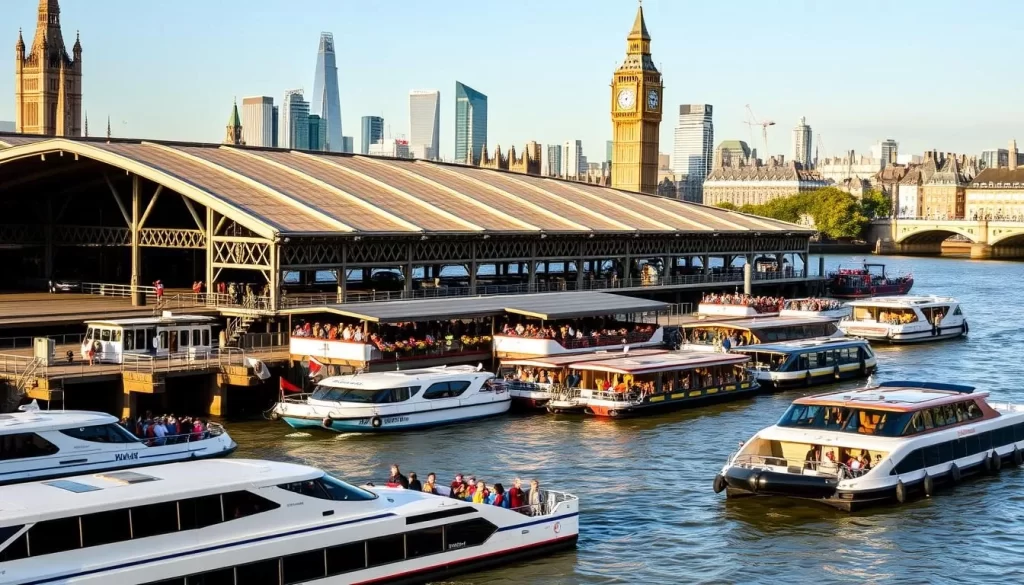
Thames Clipper Services
Thames Clippers, officially known as Uber Boat by Thames Clippers, operate regular river bus services that connect major landmarks along the Thames. You can travel from Putney in the west to Woolwich in the east, enjoying a scenic way to see London’s iconic sights.
The river bus services are fully integrated into the Transport for London (TfL) payment system. This means you can use your Oyster or contactless card to pay for tickets, making it a convenient option for your journeys across London.
River Bus Routes and Tickets
The river bus offers four main routes with clearly marked piers and comfortable seating. Onboard facilities include bathrooms and cafes selling refreshments, ensuring a pleasant journey along the river.
| Route | Main Stops | Frequency |
|---|---|---|
| Putney to Woolwich | Putney, Westminster, Tower Bridge, Woolwich | Every 20 minutes |
| Westminster to St. Katherine’s | Westminster, London Bridge, St. Katherine’s | Every 30 minutes |
| Putney to Canary Wharf | Putney, Chelsea Harbour, Canary Wharf | Every 20 minutes |
Taking the river bus is not only a practical mode of transportation but also a sightseeing opportunity. You’ll cruise past landmarks like the Houses of Parliament, London Eye, Tower Bridge, and Canary Wharf from a unique vantage point on the river.
London’s Iconic Black Cabs and Taxis
London’s iconic black cabs are a symbol of the city’s rich history and a convenient way to navigate around London. With a history dating back to 1662, these cabs have been carrying passengers for over 350 years.
Hailing a Black Cab
Hailing a black cab is straightforward; simply look for a cab with its yellow “TAXI” light illuminated, indicating it’s available, and raise your hand to flag it down. This traditional mode of transport offers a direct way to reach your destination.
Taxi Fares and Payment Options
Black cab fares are meter-operated and vary based on distance, time of day, and traffic conditions. You can pay using cash, major credit cards, or contactless payment methods, including card payments, making it a convenient option. Tipping around 10% is customary but not mandatory, adding to the flexibility of using a black cab with your card.
Cycling Around London
London has become a cyclist’s paradise, thanks to its extensive network of dedicated cycle lanes and bike-sharing systems. Cycling has become an increasingly popular way to get around London, offering a fun and eco-friendly alternative to traditional public transport.
Santander Cycles Bike Sharing
The Santander Cycles bike-sharing scheme is a convenient way to explore the city. With over 750 docking stations around central London, you can pick up a bike at one station and return it to another. To use the service, simply tap your credit or debit card at the docking station, and you’re ready to ride. The current pricing is £1.65 for 24 hours access, which includes 30 minutes of ride time.
Cycling Safety and Routes
London has developed an extensive network of dedicated Cycle Superhighways and Quietways, providing safer routes around the city. To ensure a safe ride, remember to follow the rules of the road: traffic drives on the left in the UK, so always use hand signals when turning. You can find maps of the cycling routes through the TfL website and app.
Some key benefits of cycling in London include:
- Convenient bike-sharing system with numerous docking stations
- Dedicated cycle lanes for a safer ride
- Affordable pricing for short trips around London
![]()
Unique Transport Options in London
London offers more than just the Tube for getting around; it has some unique transport options worth exploring. While the Underground and buses are convenient, there are other ways to experience the city.
IFS Cloud Cable Car Experience
The IFS Cloud Cable Car is a standout among London’s transport options. This cable car service crosses the Thames between Greenwich Peninsula and the Royal Docks, offering panoramic views of London’s skyline, including Canary Wharf and the O2 Arena. At a height of 90 meters, the journey takes approximately 10 minutes and is fully integrated into the TfL payment system, accepting Oyster and contactless cards. Here are some key benefits:
- A unique perspective on London’s landscape
- Convenient access to the ExCeL exhibition centre and other key locations
- Integrated payment system for ease of use
London Trams
London’s tram network operates primarily in South London, connecting areas like Wimbledon, Croydon, and Beckenham. With four lines and 17 miles of track, the tram service provides an efficient way to explore this part of the city. The tram fares are consistent with the bus network, at £1.75 per journey, and are included in the Hopper fare, making them an economical choice. Key features include:
- Coverage of key South London areas
- Affordable fares integrated with other public transport options
- A reliable service for locals and visitors alike
Getting To and From London’s Airports
London’s six airports offer a range of transport services to central London. You have multiple options to choose from, depending on your budget, time constraints, and preferred level of convenience.
Heathrow Airport Connections
Heathrow, London’s largest airport, provides comprehensive connections to central London. You can use the cost-effective Tube (Piccadilly Line), the faster Elizabeth Line, or the premium Heathrow Express rail service.
Gatwick, Stansted, and City Airport Options
Gatwick Airport is connected to central London via regular National Rail services and the Gatwick Express, with journey times ranging from 30-45 minutes to Victoria Station. Stansted Airport is linked to Liverpool Street Station by the Stansted Express train, taking approximately 50 minutes. London City Airport is directly connected to the DLR, making it easy to reach the financial district.
| Airport | Transport Options | Journey Time to Central London |
|---|---|---|
| Heathrow | Tube (Piccadilly Line), Elizabeth Line, Heathrow Express | 45-60 minutes |
| Gatwick | Gatwick Express, National Rail | 30-45 minutes |
| Stansted | Stansted Express | Approximately 50 minutes |
| London City | DLR | 20-30 minutes |
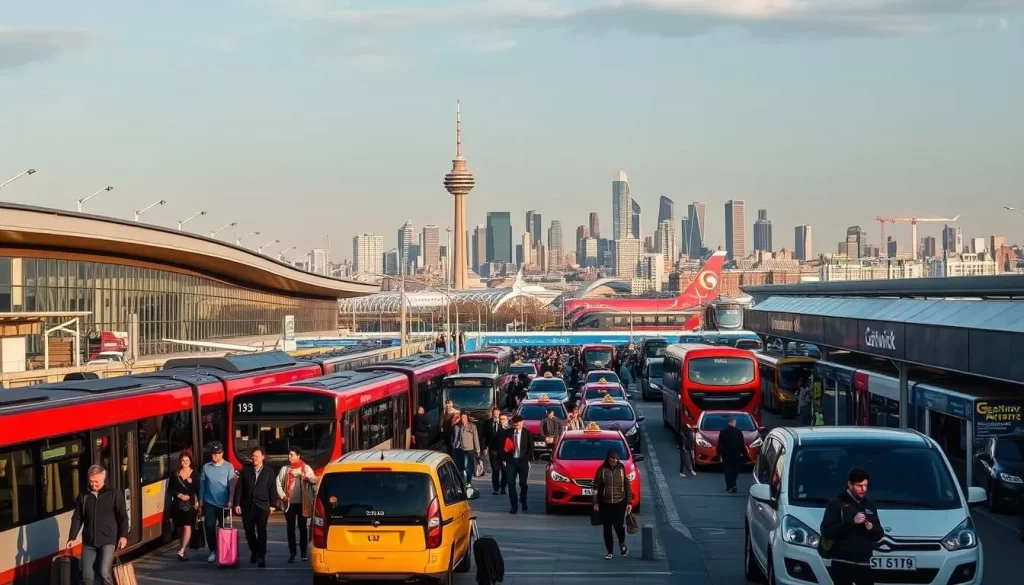
When planning your journey, consider not just the ticket price but also the total travel time, frequency of services, and proximity of the arrival station to your final destination in London. Most airport rail services now accept Oyster and contactless payment cards, making travel more convenient.
Accessibility on London Public Transport
Navigating London’s public transport can be challenging for travelers with mobility needs due to varied accessibility across different modes of transport. While some parts of the network are highly accessible, others require more planning.
Step-Free Access Information
London’s public transport system has made significant strides in accessibility. The TfL website and app offer detailed step-free access information, including a Tube map that highlights stations with level access from street to platform and from platform to train. For instance, all London buses are fully accessible, featuring low floors, ramps, and dedicated wheelchair spaces.
| Transport Mode | Step-Free Access | Accessibility Features |
|---|---|---|
| Buses | All buses | Low floors, ramps, wheelchair spaces |
| Tube | Around a quarter of stations | Step-free access at some stations |
| DLR, Overground, Elizabeth Line | Most or all stations | Built with accessibility in mind |
Services for Travelers with Disabilities
TfL offers a free Turn-up-and-go assistance service at all Tube, Overground, and Elizabeth Line stations, where staff can help passengers with mobility needs navigate the system. Additionally, many stations feature induction loops, tactile paving, and audio-visual announcements to assist travelers with hearing or visual impairments.
Money-Saving Tips for London Transport
Traveling in London doesn’t have to break the bank, thanks to its efficient public transport system and money-saving features. London’s public transportation can seem expensive at first glance, but there are several cost-saving features built into the system.
Daily and Weekly Capping
One of the most significant cost-saving features is automatic fare capping. When using an Oyster card or contactless payment, your daily charges are automatically capped at the price of a Day Travelcard for the zones you’ve traveled in. This means you can travel freely within the capped zones without incurring additional costs. Weekly capping also applies automatically when using contactless payment, ensuring you never pay more than the price of a 7-day Travelcard in a Monday-to-Sunday week.
Off-Peak Travel Savings
Traveling during off-peak hours (after 9:30 am on weekdays and all day on weekends and holidays) can save you significant money, especially on longer journeys across multiple zones. Consider planning your trips during these times to maximize your savings. You can also save money by using a Visitor Oyster card, which comes with additional perks, including discounts at select restaurants, shops, and attractions.
- Use pay as you go with daily capping for cheaper travel in London Zones 1-9.
- Add a Travelcard to your Oyster card if you’re staying for a week or longer to save time and money.
- Consider walking between attractions that are close together to discover interesting parts of London.
Conclusion: Mastering London’s Transport System
Now that you’re familiar with London’s transport options, you’re ready to explore the city like a pro. London offers multiple ways to get around, from the Tube and buses to river services and black cabs, ensuring that you can get around London efficiently.
Walking is also a great way to discover central London, and for short distances, it’s often the quickest and cheapest option. By combining different transport modes, you can tailor your journey to suit your needs and budget. TfL’s Journey Planner is an invaluable tool to help you determine the optimal route.
For most visitors, a contactless payment card or Visitor Oyster card is the most convenient way to pay for transport across around London. With this guide, you’re equipped to navigate London’s comprehensive transport system and make the most of your time in this vibrant city.
The above is subject to change.
Check back often to TRAVEL.COM for the latest travel tips and deals.
Here are some Tours & Sightseeing suggestions that might pique your interests!
